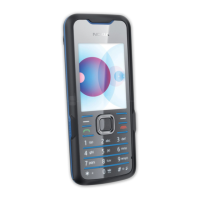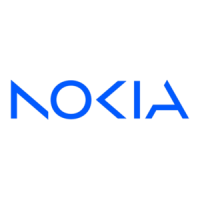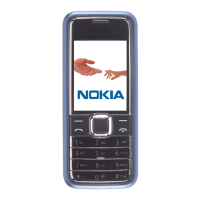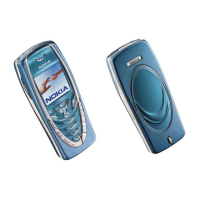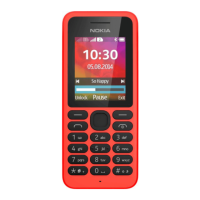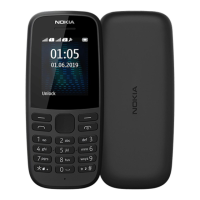Do you have a question about the Nokia Supernova 7210 and is the answer not in the manual?
Step-by-step instructions on how to make your initial phone call.
Covers essential operations like answering and ending calls, and redialing.
Explains how to save and find contacts within the phone's directory.
Learn how to lock and unlock the phone's keypad to prevent accidental presses.
Guide to changing the phone's ringtone for incoming calls.
Instructions for writing, sending, and saving SMS messages.
Explanation of the idle screen indicators like signal strength and battery level.
Details on how selection keys interact with on-screen prompts.
Step-by-step guide for inserting the SIM card into the phone.
Instructions for initiating, receiving, and ending voice calls.
Steps for making phone calls to international numbers.
How to place calls using the stored contacts in the phone book.
Accessing and redialing the most recently dialled numbers.
Guide to calling and accessing the phone's voicemail service.
Assigning phone numbers to speed dial keys for quick access.
Methods for responding to or rejecting incoming calls.
Managing multiple calls, switching between them, or rejecting new ones.
Accessing functions like hold, mute, or transfer during an active call.
Instructions for setting up and managing multi-party calls.
How to increase or decrease the sound volume during calls.
Enabling and disabling the keypad lock feature to prevent accidental input.
Overview of phone book storage capacity and features.
Steps to add new contacts and navigate the phone book memory.
Customizing how names and numbers are displayed in the phone book.
Detailed guide on adding a new contact with name and number.
How to search for and retrieve saved names and phone numbers.
Methods for removing single or multiple contacts from the phone book.
Procedure to associate phone numbers with speed dial keys.
How to initiate calls using the assigned speed dial numbers.
Setting up groups to customize call alerts for specific contacts.
Adding phone numbers to predefined or custom caller groups.
Customizing alert tones and display graphics for specific caller groups.
Viewing memory usage and available slots in the phone book.
Dialing service provider numbers directly from the phone book.
Copying and printing phone book data using the infrared port.
How to browse through menu options using scroll keys.
Overview of message types like SMS, voice, fax, and data calls.
Instructions for accessing and reading received SMS messages.
Guide to sending text messages using the phone's SMS capability.
Process for composing, editing, and saving text messages.
Settings for delivery reports and reply routing for text messages.
Receiving topic-based messages like weather or traffic updates.
Making and receiving data or fax transmissions via the phone.
Sending service requests or commands to the service provider.
Overview of call log features and network requirements.
Viewing lists of incoming calls that were missed or answered.
Accessing the list of numbers that have been dialled or attempted.
Deleting recent call records from the phone's memory.
Checking the length of incoming and outgoing calls.
Checking the costs associated with the last call or all calls.
Configuring limits for call costs based on units or currency.
Introduction to customizing phone alerts for different environments.
Switching between profiles and personalizing their settings.
Defining how the phone alerts the user to incoming voice calls.
Setting the ringtone for calls and adjusting its volume level.
Enabling or disabling the vibration alert for incoming calls.
Setting tones for text messages and adjusting keypad sound volume.
Configuring warning tones and profile-specific settings like auto-answer.
Setting the alarm time, enabling or disabling the alarm clock.
Configuring the phone's clock, time format, and display.
Procedure for setting the current time on the phone.
Options for call handling, including Anykey Answer and Automatic Redial.
Using speed dial keys for quick call initiation.
Managing incoming calls while another call is in progress.
Setting whether your phone number is displayed to the recipient.
Managing calls on multiple subscriber lines if supported by SIM card.
Selecting display language and configuring cell info display.
Storing, editing, or erasing phone numbers assigned to the SIM card.
Customizing the power-on message and selecting network operators.
Configuring the phone to request a PIN code upon startup.
Restricting outgoing and incoming calls using barring modes.
Limiting outgoing calls to a predefined list of numbers.
Specifying allowed callers and recipients for calls.
Adjusting phone security to prevent unauthorized use.
Modifying security, PIN, PIN2, and barring passwords.
Allowing or preventing the selection of different phone lines.
Objective and gameplay for the picture-matching memory game.
Instructions for playing the classic snake game on the phone.
Gameplay details for the logic puzzle involving figure combinations.
Operations for addition, subtraction, multiplication, and division.
How to view notes, reminders, meetings, and birthdays for a specific date.
Creating new notes, reminders, or call entries in the calendar.
Steps to receive data from another device using the infrared port.
How to send data like graphics or contacts via the infrared port.
Understanding the indicators for an active or failed IR connection.
Guidelines for accessing and using network-based services.
Saving network access numbers for services in phone memory.
Obtaining lists of available network services directly to the phone.
Bookmark frequently used network services for quick access.
Accessing bookmarked services or retrieving latest information.
Adding custom service addresses to personal bookmarks.
Connecting to services and entering keywords if required.
Information on the 5-digit security code for phone protection.
Explanation of PIN codes for SIM card protection and function access.
Details on PUK codes for unblocking PIN and PIN2 codes.
Password required for the Call Barring service.
Overview of approved batteries and their characteristics.
Guidelines for charging, discharging, and maintaining battery performance.
Rules for using the phone safely while driving a vehicle.
Guidelines for phone usage in various environments and potential interferences.
Information on potential RF signal interference with other electronic devices.
Recommendations for maintaining safe distance from pacemakers.
Notes on potential interference between the phone and hearing aids.
Information on potential interference with medical devices in healthcare facilities.
Potential effects of RF signals on vehicle electronic systems.
Adherence to posted notices regarding phone usage in specific locations.
Safety guidelines for using the phone in areas with explosive risks.
Step-by-step instructions on how to make your initial phone call.
Covers essential operations like answering and ending calls, and redialing.
Explains how to save and find contacts within the phone's directory.
Learn how to lock and unlock the phone's keypad to prevent accidental presses.
Guide to changing the phone's ringtone for incoming calls.
Instructions for writing, sending, and saving SMS messages.
Explanation of the idle screen indicators like signal strength and battery level.
Details on how selection keys interact with on-screen prompts.
Step-by-step guide for inserting the SIM card into the phone.
Instructions for initiating, receiving, and ending voice calls.
Steps for making phone calls to international numbers.
How to place calls using the stored contacts in the phone book.
Accessing and redialing the most recently dialled numbers.
Guide to calling and accessing the phone's voicemail service.
Assigning phone numbers to speed dial keys for quick access.
Methods for responding to or rejecting incoming calls.
Managing multiple calls, switching between them, or rejecting new ones.
Accessing functions like hold, mute, or transfer during an active call.
Instructions for setting up and managing multi-party calls.
How to increase or decrease the sound volume during calls.
Enabling and disabling the keypad lock feature to prevent accidental input.
Overview of phone book storage capacity and features.
Steps to add new contacts and navigate the phone book memory.
Customizing how names and numbers are displayed in the phone book.
Detailed guide on adding a new contact with name and number.
How to search for and retrieve saved names and phone numbers.
Methods for removing single or multiple contacts from the phone book.
Procedure to associate phone numbers with speed dial keys.
How to initiate calls using the assigned speed dial numbers.
Setting up groups to customize call alerts for specific contacts.
Adding phone numbers to predefined or custom caller groups.
Customizing alert tones and display graphics for specific caller groups.
Viewing memory usage and available slots in the phone book.
Dialing service provider numbers directly from the phone book.
Copying and printing phone book data using the infrared port.
How to browse through menu options using scroll keys.
Overview of message types like SMS, voice, fax, and data calls.
Instructions for accessing and reading received SMS messages.
Guide to sending text messages using the phone's SMS capability.
Process for composing, editing, and saving text messages.
Settings for delivery reports and reply routing for text messages.
Receiving topic-based messages like weather or traffic updates.
Making and receiving data or fax transmissions via the phone.
Sending service requests or commands to the service provider.
Overview of call log features and network requirements.
Viewing lists of incoming calls that were missed or answered.
Accessing the list of numbers that have been dialled or attempted.
Deleting recent call records from the phone's memory.
Checking the length of incoming and outgoing calls.
Checking the costs associated with the last call or all calls.
Configuring limits for call costs based on units or currency.
Introduction to customizing phone alerts for different environments.
Switching between profiles and personalizing their settings.
Defining how the phone alerts the user to incoming voice calls.
Setting the ringtone for calls and adjusting its volume level.
Enabling or disabling the vibration alert for incoming calls.
Setting tones for text messages and adjusting keypad sound volume.
Configuring warning tones and profile-specific settings like auto-answer.
Setting the alarm time, enabling or disabling the alarm clock.
Configuring the phone's clock, time format, and display.
Procedure for setting the current time on the phone.
Options for call handling, including Anykey Answer and Automatic Redial.
Using speed dial keys for quick call initiation.
Managing incoming calls while another call is in progress.
Setting whether your phone number is displayed to the recipient.
Managing calls on multiple subscriber lines if supported by SIM card.
Selecting display language and configuring cell info display.
Storing, editing, or erasing phone numbers assigned to the SIM card.
Customizing the power-on message and selecting network operators.
Configuring the phone to request a PIN code upon startup.
Restricting outgoing and incoming calls using barring modes.
Limiting outgoing calls to a predefined list of numbers.
Specifying allowed callers and recipients for calls.
Adjusting phone security to prevent unauthorized use.
Modifying security, PIN, PIN2, and barring passwords.
Allowing or preventing the selection of different phone lines.
Objective and gameplay for the picture-matching memory game.
Instructions for playing the classic snake game on the phone.
Gameplay details for the logic puzzle involving figure combinations.
Operations for addition, subtraction, multiplication, and division.
How to view notes, reminders, meetings, and birthdays for a specific date.
Creating new notes, reminders, or call entries in the calendar.
Steps to receive data from another device using the infrared port.
How to send data like graphics or contacts via the infrared port.
Understanding the indicators for an active or failed IR connection.
Guidelines for accessing and using network-based services.
Saving network access numbers for services in phone memory.
Obtaining lists of available network services directly to the phone.
Bookmark frequently used network services for quick access.
Accessing bookmarked services or retrieving latest information.
Adding custom service addresses to personal bookmarks.
Connecting to services and entering keywords if required.
Information on the 5-digit security code for phone protection.
Explanation of PIN codes for SIM card protection and function access.
Details on PUK codes for unblocking PIN and PIN2 codes.
Password required for the Call Barring service.
Overview of approved batteries and their characteristics.
Guidelines for charging, discharging, and maintaining battery performance.
Rules for using the phone safely while driving a vehicle.
Guidelines for phone usage in various environments and potential interferences.
Information on potential RF signal interference with other electronic devices.
Recommendations for maintaining safe distance from pacemakers.
Notes on potential interference between the phone and hearing aids.
Information on potential interference with medical devices in healthcare facilities.
Potential effects of RF signals on vehicle electronic systems.
Adherence to posted notices regarding phone usage in specific locations.
Safety guidelines for using the phone in areas with explosive risks.
| Camera | 2 MP |
|---|---|
| Dimensions | 106 x 45 x 10.6 mm |
| Weight | 69.8 g |
| Connectivity | Bluetooth 2.0, USB 2.0 |
| Operating System | Nokia Series 40 |
| Released | 2008, October |
| Network | GSM 850 / 900 / 1800 / 1900 |
| GPRS | Class 10 |
| EDGE | Class 10 |
| SIM | Mini-SIM |
| Call records | Yes |
| Alert types | Vibration; Downloadable polyphonic, MP3 ringtones |
| Loudspeaker | Yes |
| 3.5mm jack | No |
| WLAN | No |
| Radio | Stereo FM radio with RDS |
| Messaging | SMS, MMS, Email, IM |
| Games | Yes + downloadable |
| Java | Yes, MIDP 2.0 |
| Display | TFT, 240 x 320 pixels, 2.0 inches |
| Memory | microSD |
| Battery | Li-Ion 860 mAh (BL-4CT) |
| Announced | 2008 |
| Phonebook | 2000 entries |
| Video | Yes |
| USB | microUSB |
| Browser | WAP 2.0/xHTML |
| Colors | Pink, Blue, Purple |
